
Gert-Jan Oskam was living in China in 2011 when he was in a motorcycle accident that left him paralyzed from the hips down. Now, with a combination of devices, scientists have given him control over his lower body again.
“For 12 years I’ve been trying to get back my feet,” Mr. Oskam said in a press briefing on Tuesday. “Now I have learned how to walk normal, natural.”
In a study published on Wednesday in the journal Nature, researchers in Switzerland described implants that provided a “digital bridge” between Mr. Oskam’s brain and his spinal cord, bypassing injured sections. The discovery allowed Mr. Oskam, 40, to stand, walk and ascend a steep ramp with only the assistance of a walker. More than a year after the implant was inserted, he has retained these abilities and has actually showed signs of neurological recovery, walking with crutches even when the implant was switched off.
“We’ve captured the thoughts of Gert-Jan, and translated these thoughts into a stimulation of the spinal cord to re-establish voluntary movement,” Grégoire Courtine, a spinal cord specialist at the Swiss Federal Institute of Technology, Lausanne, who helped lead the research, said at the press briefing.
Jocelyne Bloch, a neuroscientist at the University of Lausanne who placed the implant in Mr. Oskam, added, “It was quite science fiction in the beginning for me, but it became true today.”
There have been a number of advances in technological spinal cord injury treatment in recent decades. In 2016, a group of scientists led by Dr. Courtine was able to restore the ability to walk in paralyzed monkeys, and another helped a man regain control of his crippled hand. In 2018, a different group of scientists, also led by Dr. Courtine, devised a way to stimulate the brain with electrical-pulse generators, allowing partially paralyzed people to walk and ride bicycles again. Last year, more advanced brain stimulation procedures allowed paralyzed subjects to swim, walk and cycle within a single day of treatment.
Mr. Oskam had undergone stimulation procedures in previous years, and had even regained some ability to walk, but eventually his improvement plateaued. At the press briefing, Mr. Oskam said that these stimulation technologies had left him feeling that there was something foreign about the locomotion, an alien distance between his mind and body.
The new interface changed this, he said: “The stimulation before was controlling me, and now I’m controlling the stimulation.”
In the new study, the brain-spine interface, as the researchers called it, took advantage of an artificial intelligence thought decoder to read Mr. Oskam’s intentions — detectable as electrical signals in his brain — and match them to muscle movements. The etiology of natural movement, from thought to intention to action, was preserved. The only addition, as Dr. Courtine described it, was the digital bridge spanning the injured parts of the spine.
Andrew Jackson, a neuroscientist at Newcastle University who was not involved in the study, said: “It raises interesting questions about autonomy, and the source of commands. You’re continuing to blur the philosophical boundary between what’s the brain and what’s the technology.”
Dr. Jackson added that scientists in the field had been theorizing about connecting the brain to spinal cord stimulators for decades, but that this represented the first time they had achieved such success in a human patient. “It’s easy to say, it’s much more difficult to do,” he said.
To achieve this result, the researchers first implanted electrodes in Mr. Oskam’s skull and spine. The team then used a machine-learning program to observe which parts of the brain lit up as he tried to move different parts of his body. This thought decoder was able to match the activity of certain electrodes with particular intentions: One configuration lit up whenever Mr. Oskam tried to move his ankles, another when he tried to move his hips.
Then the researchers used another algorithm to connect the brain implant to the spinal implant, which was set to send electrical signals to different parts of his body, sparking movement. The algorithm was able to account for slight variations in the direction and speed of each muscle contraction and relaxation. And, because the signals between the brain and spine were sent every 300 milliseconds, Mr. Oskam could quickly adjust his strategy based on what was working and what wasn’t. Within the first treatment session he could twist his hip muscles.
Over the next few months, the researchers fine-tuned the brain-spine interface to better fit basic actions like walking and standing. Mr. Oskam gained a somewhat healthy-looking gait and was able to traverse steps and ramps with relative ease, even after months without treatment. Moreover, after a year in treatment, he began noticing clear improvements in his movement without the aid of the brain-spine interface. The researchers documented these improvements in weight-bearing, balancing and walking tests.
Now, Mr. Oskam can walk in a limited way around his house, get in and out of a car and stand at a bar for a drink. For the first time, he said, he feels like he is the one in control.
The researchers acknowledged limitations in their work. Subtle intentions in the brain are difficult to distinguish, and although the current brain-spine interface is suitable for walking, the same probably cannot be said for restoring upper body movement. The treatment is also invasive, requiring multiple surgeries and hours of physical therapy. The current system does not fix all spinal cord paralysis.
But the team was hopeful that further advances would make the treatment more accessible and more systematically effective. “This is our true objective,” Dr. Courtine said, “to make this technology available across the world for all the patients who need it.”
Oliver Whang is a reporting fellow for The Times, focusing on science and health. @oliverwhang21
Source: Read Full Article